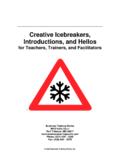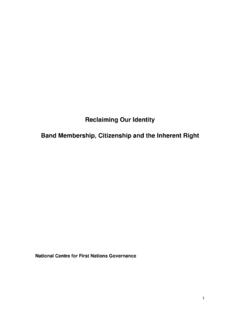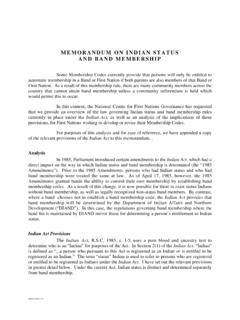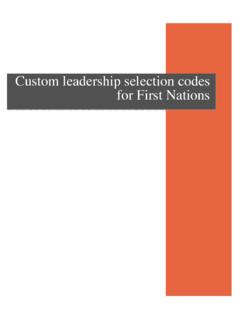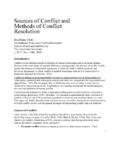Transcription of NCFNG | Systems Of Conflict Resolution Within First ...
1 Patricia L. Tait Systems of Conflict Resolution Within First nations communities : honouring The Elders, honouring The Knowledge Research Paper for the National Centre for First nations Governance 2007. Systems OF Conflict Resolution Within First nations . communities . honouring the Elders, honouring the Knowledge 2007, Patricia L. Tait1. First nations people are well aware that many of our governments and citizens struggle to move beyond the violence and dysfunction that characterizes some individuals, families and communities . Within some community settings, drugs and alcohol prevail, family members are involved in the justice Systems and children are being apprehended.
2 These situations are being compounded by significant unemployment and lack of both education and employment opportunities. Loss of culture, language and tradition further exacerbates the problems. All of these are primarily attributable to the impact of colonialism. The subsequent efforts by Canadian society to address these concerns through non-Indigenous interventions, developed and delivered by non- First nations individuals, have most often only extended colonial impacts. First nations people recognize that these efforts have been unsuccessful and have only served to further disrupt the traditional infrastructures.
3 The position, that control over peace making Systems must rest with the First nations , has been reinforced by justice reports authored by Canadian government Previously mentioned non-Indigenous interventions have impaired the First Nationsns community's inherent ability to provide a peaceful and safe environment for all their citizens. It is important to note that the author does not equate non-indigenous understanding of justice with the limited definition attached to criminal justice Systems . Rather, the term justice that is used is reflective of wellness, fairness and balance for First nations and their people Within Canadian society.
4 Without a doubt these self determined forms of justice, First nations community controlled, community empowered models of intervention, are better equipped to deal with internal issues in a more wholistic way. This justice definition requires recognition of the wisdom of First nations people to define, address and heal the wounds of their own. 1. THE HEALING WAY: Recognition and Respect Efforts are being made by First nations in both urban and reserve communities to take back ownership of Conflict Resolution , healing, and justice to regain control of the issues that present themselves as problematic for the people.
5 Conflict occurs on many levels and is a multifaceted concept that necessarily will elicit diverse responses. Conflict may occur between individuals, families and interest groups Within the community, between communities , and certainly between First nations , their government structures and Canadian governments. The complexity of this situation, in concert with Resolution which itself has many faces, can appear to be overwhelming. However, it presents not only the need for strategic interventions, but also a world of opportunities Within First nations seeking projects for their communities .
6 That being said, First nations Conflict Resolution must be committed to honouring the values, processes, and traditions of the people, while recognizing that those imperative constructs must survive Within a Canadian society that will often shun alternatives to the status-quo. First nations initiatives may initially necessitate approaches which operate concurrently with Canadian Systems . This is particularly true when criminal justice issues are involved and it will remain true until the time when there is recognized and implemented autonomy for First Nation's peoples.
7 This is a vision that has been articulated by Patricia Monture when she stated, When Aboriginal people assert jurisdiction in matters of so-called criminal justice (which is not by any means how I conceive what justice is), we hear in response that there is a single system of criminal laws in Canada. Non-Aboriginal people fear the results of Aboriginal Peoples asserting jurisdiction over criminal law matters. What should be heard is the simple plea of Aboriginal Peoples to have both the resources and the control to address the many problems that our communities now face.
8 People must stop fearing the possible creation of many Aboriginal criminal codes. What Aboriginal people seek is the acceptance that there can be more than one valid and legitimate way to address dispute and wrong-doings. Aboriginal people do not wish to displace anyone else's right to be governed by the legitimate and properly consented to laws of their nation. To do such a thing would amount to becoming oppressors 2. ourselves. Our challenge is not a challenge to your rights to be in your own unique way, but a simple desire to follow our own Though acceptance of this concept may require creative approaches, it is important that First nations commit to undertaking that challenge.
9 As stated by Monture it is indeed our own way'. It is important to recognize the great diversity that exists across First nations and their communities . First Nation's communities will necessarily have different priorities, specific to the needs of their own people. Youth, justice, policing, substance abuse, language, cultural, ceremonial and elder 's teachings represent just a sample of the focuses that may be taken. All these areas require Conflict Resolution strategies at some level. Priorities and projects may also be governed by the expertise and resources that are locally available.
10 Projects addressing the same issues could look very different and that is attributable to the uniqueness of each First Nation. For example among many west coast nations , cleansing is traditionally achieved through water baths, while their central and eastern brothers use the sweat lodge for similar reasons. In the face of this complexity and the plethora of on- and off-reserve issues across Turtle Island (in particular throughout Canada), there are innovative and inspiring projects of Conflict Resolution taking place. communities with more sophisticated infrastructures in some instances have taken on larger projects addressing a number of concerns, while some initiatives are being administered by one committed individual in a given community.



